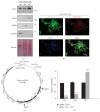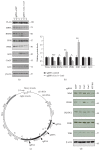Efficient Mitochondrial Genome Editing by CRISPR/Cas9
- PMID: 26448933
- PMCID: PMC4581504
- DOI: 10.1155/2015/305716
Efficient Mitochondrial Genome Editing by CRISPR/Cas9
Abstract
The Clustered Regularly Interspaced Short Palindromic Repeats (CRISPR)/Cas9 system has been widely used for nuclear DNA editing to generate mutations or correct specific disease alleles. Despite its flexible application, it has not been determined if CRISPR/Cas9, originally identified as a bacterial defense system against virus, can be targeted to mitochondria for mtDNA editing. Here, we show that regular FLAG-Cas9 can localize to mitochondria to edit mitochondrial DNA with sgRNAs targeting specific loci of the mitochondrial genome. Expression of FLAG-Cas9 together with gRNA targeting Cox1 and Cox3 leads to cleavage of the specific mtDNA loci. In addition, we observed disruption of mitochondrial protein homeostasis following mtDNA truncation or cleavage by CRISPR/Cas9. To overcome nonspecific distribution of FLAG-Cas9, we also created a mitochondria-targeted Cas9 (mitoCas9). This new version of Cas9 localizes only to mitochondria; together with expression of gRNA targeting mtDNA, there is specific cleavage of mtDNA. MitoCas9-induced reduction of mtDNA and its transcription leads to mitochondrial membrane potential disruption and cell growth inhibition. This mitoCas9 could be applied to edit mtDNA together with gRNA expression vectors without affecting genomic DNA. In this brief study, we demonstrate that mtDNA editing is possible using CRISPR/Cas9. Moreover, our development of mitoCas9 with specific localization to the mitochondria should facilitate its application for mitochondrial genome editing.
Figures




Similar articles
-
Knock-In Strategy for Editing Human and Zebrafish Mitochondrial DNA Using Mito-CRISPR/Cas9 System.ACS Synth Biol. 2019 Apr 19;8(4):621-632. doi: 10.1021/acssynbio.8b00411. Epub 2019 Apr 10. ACS Synth Biol. 2019. PMID: 30955321
-
RNA-guided genome editing in plants using a CRISPR-Cas system.Mol Plant. 2013 Nov;6(6):1975-83. doi: 10.1093/mp/sst119. Epub 2013 Aug 17. Mol Plant. 2013. PMID: 23956122
-
CRISPR/Cas9-Based Genome Editing for Disease Modeling and Therapy: Challenges and Opportunities for Nonviral Delivery.Chem Rev. 2017 Aug 9;117(15):9874-9906. doi: 10.1021/acs.chemrev.6b00799. Epub 2017 Jun 22. Chem Rev. 2017. PMID: 28640612 Review.
-
CRISPR/Cas9-mediated mutagenesis at microhomologous regions of human mitochondrial genome.Sci China Life Sci. 2021 Sep;64(9):1463-1472. doi: 10.1007/s11427-020-1819-8. Epub 2021 Jan 6. Sci China Life Sci. 2021. PMID: 33420919
-
CRISPR/Cas9 for genome editing: progress, implications and challenges.Hum Mol Genet. 2014 Sep 15;23(R1):R40-6. doi: 10.1093/hmg/ddu125. Epub 2014 Mar 20. Hum Mol Genet. 2014. PMID: 24651067 Review.
Cited by
-
Mitochondrial diseases and mtDNA editing.Genes Dis. 2023 Aug 9;11(3):101057. doi: 10.1016/j.gendis.2023.06.026. eCollection 2024 May. Genes Dis. 2023. PMID: 38292200 Free PMC article. Review.
-
The Mitochondrial Genome in Aging and Disease and the Future of Mitochondrial Therapeutics.Biomedicines. 2022 Feb 18;10(2):490. doi: 10.3390/biomedicines10020490. Biomedicines. 2022. PMID: 35203698 Free PMC article. Review.
-
Emerging model systems and treatment approaches for Leber's hereditary optic neuropathy: Challenges and opportunities.Biochim Biophys Acta Mol Basis Dis. 2020 Jun 1;1866(6):165743. doi: 10.1016/j.bbadis.2020.165743. Epub 2020 Feb 24. Biochim Biophys Acta Mol Basis Dis. 2020. PMID: 32105823 Free PMC article. Review.
-
Mitochondrial genome variation and prostate cancer: a review of the mutational landscape and application to clinical management.Oncotarget. 2017 Aug 4;8(41):71342-71357. doi: 10.18632/oncotarget.19926. eCollection 2017 Sep 19. Oncotarget. 2017. PMID: 29050365 Free PMC article. Review.
-
Investigating the Impact of a Curse: Diseases, Population Isolation, Evolution and the Mother's Curse.Genes (Basel). 2022 Nov 18;13(11):2151. doi: 10.3390/genes13112151. Genes (Basel). 2022. PMID: 36421825 Free PMC article. Review.
References
Publication types
MeSH terms
Substances
LinkOut - more resources
Full Text Sources
Other Literature Sources

